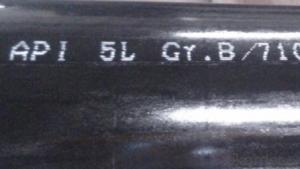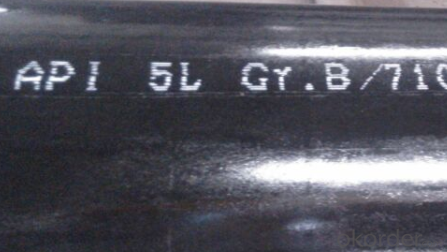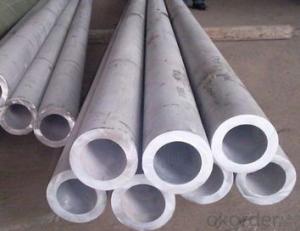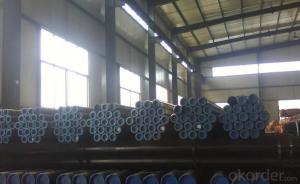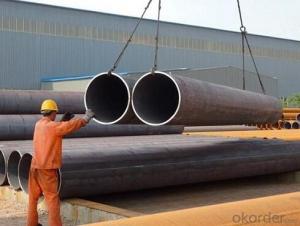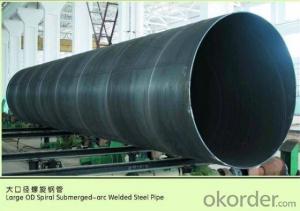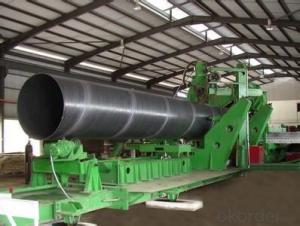Slaw Pipe Api 5l Gr. b Used for Oil and Gas Transportation
- Loading Port:
- Tianjin
- Payment Terms:
- TT OR LC
- Min Order Qty:
- 50 m.t.
- Supply Capability:
- 1000 m.t./month
OKorder Service Pledge
OKorder Financial Service
You Might Also Like
1、Structure of Slaw Pipe Api 5l Gr. b Used for Oil and Gas Transportation:
Seamless pipe is formed by drawing a solid billet over a piercing rod to create the hollow shell. As the manufacturing process does not include any welding, seamless pipes are perceived to be stronger and more reliable. Historically seamless pipe was regarded as withstanding pressure better than other types, and was often more easily available than welded pipe.
2、Main Features of Slaw Pipe Api 5l Gr. b Used for Oil and Gas Transportation:
• High manufacturing accuracy
• High strength
• Small inertia resistance
• Strong heat dissipation ability
• Good visual effect
• Reasonable price
3、Slaw Pipe Api 5l Gr. b Used for Oil and Gas Transportation Specification:
Standard | GB, DIN, ASTM ASTM A106-2006, ASTM A53-2007 |
Grade | 10#-45#, 16Mn 10#, 20#, 45#, 16Mn |
Thickness | 8 - 33 mm |
Section Shape | Round |
Outer Diameter | 133 - 219 mm |
Place of Origin | He Bei, China (Mainland) |
Secondary Or Not | Non-secondary |
Application | Hydraulic Pipe |
Technique | Cold Drawn |
Certification | API |
Surface Treatment | factory state or painted black |
Special Pipe | API Pipe |
Alloy Or Not | Non-alloy |
Length | 5-12M |
Outer Diameter | 21.3-610mm |
Grade | 20#, 45#, Q345, API J55, API K55, API L80, API N80, API P110, A53B |
Standard | ASME, ASTM |
1) Material:20#(ASTM A 106/A53 GRB.API5LGRB,GB),45#,16Mn,10#.
2) Specification range:OD:21.3-610mm,WT:6-70mm,length:6-12m or according to the requirement of clients.
3) Excutive standards:GB,ASME API5L.ASTM A 106/A53,Despite of the above standards,we can also supply seamless steel pipe with standard of DIN,JIS,and so on,and also develop new products according to the requirements of our clients!
4) Surface:black lacquered,varnish coating or galvanized.
5) Ends:Beveled or square cut,plastic capped,painted.
6) Packing:bundles wrapped with strong steel strip,seaworthy packing.
4、Packaging & Delivery of Slaw Pipe Api 5l Gr. b Used for Oil and Gas Transportation:
Packaging Details: | seaworthy package,bundles wrapped with strong steel strip |
Delivery Detail: | 30-45days after received 30%TT |
5、FAQ of Slaw Pipe Api 5l Gr. b Used for Oil and Gas Transportation:
①How is the quality of your products?
Our products are manufactured strictly according to national and internaional standard, and we take a test
on every pipe before delivered out. If you want see our quality certifications and all kinds of testing report, please just ask us for it.
Guaranteed: If products’ quality don’t accord to discription as we give or the promise before you place order, we promise 100% refund.
②How about price?
Yes, we are factory and be able to give you lowest price below market one, and we have a policy that “ for saving time and absolutely honest business attitude, we quote as lowest as possible for any customer, and discount can be given according to quantity”,if you like bargain and factory price is not low enough as you think, just don’t waste your time.Please trust the quotation we would give you, it is professional one.
③Why should you chose us?
Chose happens because of quality, then price, We can give you both.Additionally, we can also offer professional products inquiry, products knowledge train(for agents), smooth goods delivery, exellent customer solution proposals.Our service formula: good quality+good price+good service=customer’s trust
SGS test is available, customer inspection before shipping is welcome, third party inspection is no problem.
6、Slaw Pipe Api 5l Gr. b Used for Oil and Gas Transportation Images:
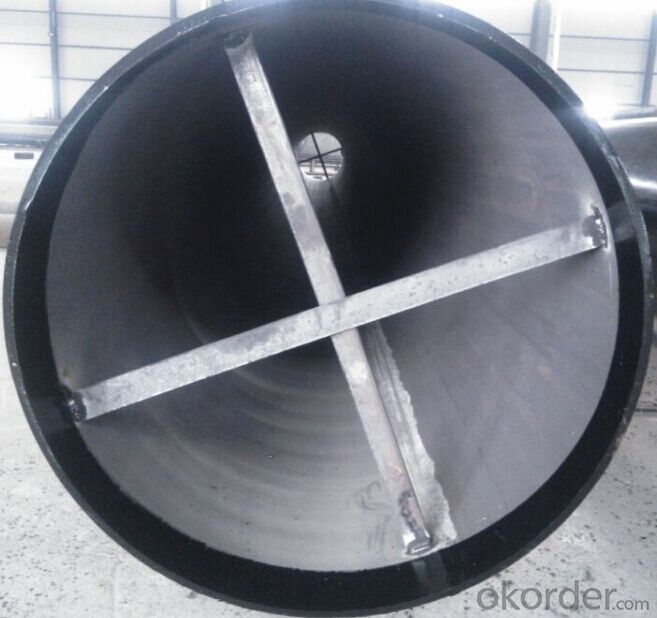
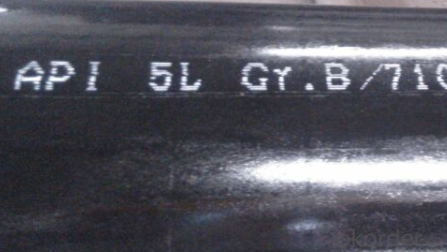
- Q: What is the standard length of steel pipes?
- The standard length of steel pipes can vary depending on the application and industry, but commonly they are available in lengths of 20 feet or 6 meters.
- Q: What is the tensile strength of steel pipes?
- The tensile strength of steel pipes can vary depending on the grade and type of steel used. However, in general, steel pipes have a high tensile strength. Typically, carbon steel pipes have a tensile strength range of 370 to 700 megapascals (MPa), while alloy steel pipes can have a tensile strength range of 770 to 1200 MPa. These high tensile strengths allow steel pipes to withstand high levels of pressure and stress, making them suitable for a wide range of applications such as in the construction, oil and gas, and automotive industries. It is important to note that the tensile strength of steel pipes can also be influenced by other factors such as the manufacturing process, heat treatment, and the presence of any defects or imperfections. Therefore, it is advisable to consult the specifications provided by the manufacturer or industry standards to determine the exact tensile strength of a specific steel pipe.
- Q: How are steel pipes coated for aesthetic purposes?
- There are various ways to coat steel pipes for aesthetic purposes. One commonly used method is to apply a powder coating. This involves spraying a dry powder onto the pipe's surface and then heating it to create a durable and attractive finish. Powder coating offers a wide range of color options and provides a smooth coating. Another method is electroplating, which involves immersing the pipe in a solution containing metal ions and passing an electric current through it. This creates a thin, decorative layer on the surface of the pipe. Electroplating can produce shiny, reflective surfaces or more matte, textured appearances. Painting is also a popular method for coating steel pipes aesthetically. It involves applying liquid paint or enamel to the pipe's surface. By choosing different colors, textures, and finishes, painting allows for a variety of aesthetic possibilities. However, it is crucial to use paint specifically formulated for metal surfaces and capable of withstanding environmental conditions. In addition to these methods, steel pipes can be coated using techniques like hot-dip galvanizing or metal cladding. These processes involve applying a layer of another metal, such as zinc or aluminum, to the pipe's surface. This not only enhances the appearance but also protects against corrosion, extending the pipe's lifespan. Overall, there are multiple methods available for aesthetically coating steel pipes. Each method has its own advantages and should be selected based on the desired appearance, durability, and environmental conditions. Factors like color, texture, finish, and protective properties must be considered to ensure the desired aesthetic result is achieved.
- Q: What are the different end finishes available for steel pipes?
- Steel pipes have various end finishes available, depending on the specific application and requirements. Some common options include: 1. Plain End: The simplest and most common type, where the pipe ends are cut square without any additional treatment or threading. 2. Beveled End: This involves an angled cut at the end of the pipe, typically at a 30-degree angle. It facilitates better welding and ensures a seamless transition between pipes. 3. Threaded End: These ends are useful for connecting pipes with other components using threaded fittings. The pipe ends are cut with external threads, allowing for easy assembly and disassembly. 4. Coupling End: Similar to threaded ends, coupling ends have internal threads. This enables pipes to be connected using couplings or connectors. 5. Grooved End: This type is commonly used in fire protection systems or other applications that require quick and easy installation. The pipe ends are grooved, and a coupling is used to connect and secure the pipes. 6. Flanged End: Flanged ends have a flat, wide surface with holes for bolts. They are used when the pipe needs to be connected to other components using flanges, such as in piping systems or equipment connections. Each of these end finishes serves a specific purpose and is chosen based on the application's requirements. The selection depends on factors like the desired type of connection, intended use of the pipe, and the applicable industry standards and regulations.
- Q: How are steel pipes cleaned and maintained?
- Steel pipes are cleaned and maintained through a combination of mechanical and chemical methods. Mechanical cleaning involves removing any loose debris or scale using tools like wire brushes or high-pressure water jets. Chemical cleaning may be used to dissolve any stubborn deposits or corrosion using suitable solvents or acids. Regular inspection and maintenance are essential to identify and address any potential issues such as leaks, rust, or structural damage. Coatings, such as paint or anti-corrosion materials, are often applied to protect steel pipes from environmental factors and extend their lifespan.
- Q: How do you determine the maximum allowable stress for steel pipes?
- To determine the maximum allowable stress for steel pipes, several factors need to be considered. These factors include the type of steel, the pipe's dimensions, and the operating conditions under which the pipe will be used. Firstly, the type of steel plays a crucial role in determining the maximum allowable stress. Different grades of steel have varying mechanical properties, including yield strength, tensile strength, and elongation. These properties define the material's ability to withstand stress before deformation or failure. Therefore, understanding the specific grade of steel used in the pipes is vital in determining the maximum allowable stress. Secondly, the dimensions of the pipe are essential. The outer diameter, wall thickness, and length all influence the pipe's strength and ability to handle stress. By calculating the cross-sectional area and moment of inertia, engineers can determine the pipe's resistance to bending and axial stresses. These calculations, along with the material properties, help establish the maximum allowable stress. Lastly, the operating conditions under which the pipe will be subjected to are critical. Factors such as temperature, pressure, and the presence of corrosive substances can significantly impact a steel pipe's maximum allowable stress. Elevated temperatures can affect the steel's mechanical properties, while high pressures can induce additional stress. The presence of corrosive substances can lead to material degradation and decrease the pipe's strength. Considering these operational factors is crucial in determining the maximum allowable stress. To sum up, determining the maximum allowable stress for steel pipes involves considering the specific grade of steel, the pipe's dimensions, and the operating conditions. By analyzing these factors, engineers can ensure that the steel pipe is designed and used within its safe stress limits.
- Q: How are steel pipes used in industrial manufacturing processes?
- Steel pipes are commonly used in industrial manufacturing processes for various purposes such as transporting fluids, gases, and solids, as well as providing structural support. They are used in industries like oil and gas, construction, automotive, and chemical manufacturing. Steel pipes offer high durability, strength, and resistance to corrosion, making them ideal for handling harsh environments and high-pressure applications. Additionally, they can be easily welded, bent, and manipulated to fit specific requirements, allowing for efficient and cost-effective installations.
- Q: Can steel pipes be used for transporting slurry?
- Yes, steel pipes can be used for transporting slurry. Steel pipes are commonly used in various industries, including mining, construction, and oil and gas, for transporting different types of fluids, including slurry. Slurry is a mixture of solid particles suspended in a liquid, usually water, and steel pipes have the required strength and durability to handle the abrasive nature of slurry. Additionally, steel pipes have excellent resistance to corrosion, which is crucial when dealing with slurry that may contain corrosive elements. The smooth inner surface of steel pipes also helps to minimize friction and ensure efficient flow of the slurry. Overall, steel pipes are a reliable and commonly used choice for transporting slurry due to their strength, durability, corrosion resistance, and smooth inner surface.
- Q: What is the difference between steel pipes and cast iron soil pipes?
- Steel pipes and cast iron soil pipes differ in their composition and characteristics. Steel pipes are made of an alloy of iron and carbon, providing them with high strength and durability. They are commonly used for transporting fluids and gases, and are resistant to corrosion. On the other hand, cast iron soil pipes are made from molten iron that is poured into molds. They are primarily used for drainage and sewage systems due to their excellent soundproofing properties. Cast iron soil pipes are more resistant to fire and have a longer lifespan compared to steel pipes. Additionally, cast iron soil pipes are typically heavier and thicker than steel pipes, making them more suitable for underground installations. However, steel pipes are lighter and easier to handle, making them a preferred choice for above-ground applications. Ultimately, the choice between steel pipes and cast iron soil pipes depends on the specific requirements of the project, such as the intended use, location, and budget.
- Q: Are steel pipes resistant to earthquakes?
- Steel pipes are generally considered to be more resistant to earthquakes compared to other materials such as concrete or PVC pipes. This is due to the inherent properties of steel, which include its high tensile strength and flexibility. During an earthquake, steel pipes can absorb and distribute the seismic energy more effectively, allowing them to better withstand the shaking and ground movements. Additionally, steel pipes have the ability to deform without rupturing or collapsing, minimizing the risk of structural failure. However, it is important to note that the earthquake resistance of steel pipes ultimately depends on various factors such as the design, installation, and overall structural integrity of the piping system. Proper engineering and construction practices should be followed to ensure the highest level of earthquake resistance for steel pipes.
Send your message to us
Slaw Pipe Api 5l Gr. b Used for Oil and Gas Transportation
- Loading Port:
- Tianjin
- Payment Terms:
- TT OR LC
- Min Order Qty:
- 50 m.t.
- Supply Capability:
- 1000 m.t./month
OKorder Service Pledge
OKorder Financial Service
Similar products
Hot products
Hot Searches
Related keywords
